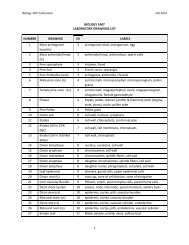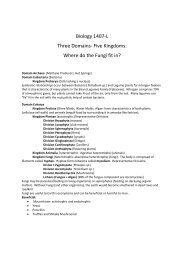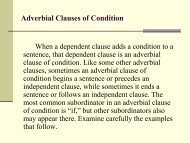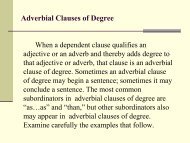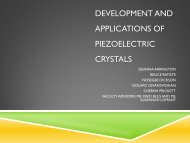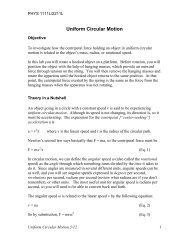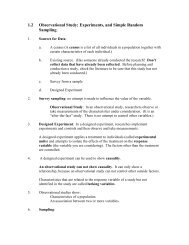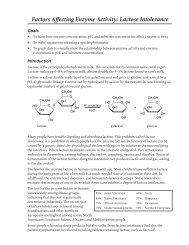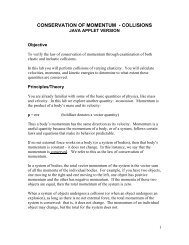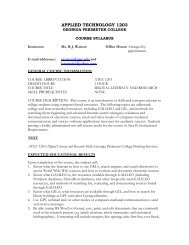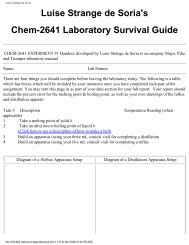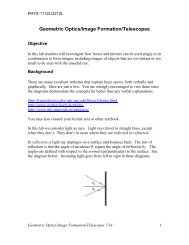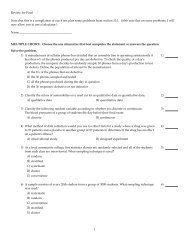Lab 2
Lab 2
Lab 2
You also want an ePaper? Increase the reach of your titles
YUMPU automatically turns print PDFs into web optimized ePapers that Google loves.
Conversion Factors in CalculationsSample Problem 20.025 × 4.62Solve:3.44=Solution:On the calculator, the steps are0.025 × 4.62 ÷ 3.44 = 0.033575581 calculator display= 0.034 final answer rounded to two significant figuresAddition/subtraction When you add or subtract numbers, the reported answer has the same numberof decimal places as the measured number with the fewest decimal places. See Sample Problem 3.Sample Problem 3Add: 2.11 + 104.056 + 0.1205Solution: 2.11 two decimal places104.0560.1205106.2865 calculator display106.29 final answer rounded to two decimal placesC. Conversion Factors for LengthMetric factors If a quantity is expressed in two different metric units, a metric equality can be stated.For example, the length of 1 meter is the same as 100 cm, which gives the equality 1 m = 100 cm. Whenthe values in the equality are written as a fraction, the ratio is called a conversion factor. Two fractionsare always possible, and both are conversion factors for the equality.Equality1 m = 100 cmConversion Factors100 cm1 m and 1 m100 cmMetric–U.S. system factors When a quantity measured in a metric unit is compared to its measuredquantity in a U.S. unit, a metric–U.S. conversion factor can be written. For example, 1 inch is thesame length as 2.54 cm, as seen in Figure 1.1 in.12 31 2 3 4 5 6 7 81 cm 2.54 cmFigure 1Comparing centimeters and inchesFor the length of 1 inch, two conversion factors can be written.Equality1 in. = 2.54 cmConversion Factors2.54 cm1 in.and1 in.2.54 cm
Conversion Factors in CalculationsD. Conversion Factors for VolumeIn the metric system, equalities for volume can be written along with their corresponding conversionfactors. A useful metric–U.S. equality is the relationship of 1 quart equaling 946 mL.Equality1 L = 1000 mLConversion Factors1000 mL 1 Land1 L 1000 mL1 qt = 946 mL946 mL1 qtand1 qt946 mLE. Conversion Factors for MassIn the metric system, equalities for mass can be written along with their corresponding conversionfactors. A useful metric–U.S. equality is the relationship of 454 g equaling 1 pound.Equality1 kg = 1000 gConversion Factors1000 g 1 kgand1 kg 1000 g1 lb = 454 g454 g1 lband1 lb454 gF. Percent by MassA percent (%) by mass gives the number of grams of each component in 100 grams of the mixture. Itis calculated by dividing the mass of each component by the mass of the mixture and multiplying by100.Mass (g) of component 1 × 100 = % of component 1Mass (g) of the mixtureMass (g) of component 2 × 100 = % of component 2Mass (g) of the mixtureG. Converting TemperatureTemperature measures the intensity of heat in a substance. A substance with little heat feels cold.Where the heat intensity is great, a substance feels hot. The temperature of our bodies is an indicationof the heat produced. An infection may cause body temperature to deviate from normal. On theCelsius scale, water freezes at 0°C; on the Fahrenheit scale, water freezes at 32°F. A Celsius temperatureis converted to its corresponding Fahrenheit temperature by using the following equation:T F = 1.8 (T C ) + 32When the Fahrenheit temperature is known, the Celsius temperature is determined by rearranging theequation. Be sure you subtract 32 from the T F , then divide by 1.8.T C = (T F – 32)1.8A Celsius temperature can be converted to a Kelvin temperature by using the following equation:T K = T C + 273
Conversion Factors in Calculations<strong>Lab</strong> InformationTime: 3 hrComments: Tear out the report sheets and place them beside the procedures.Determine what the smallest lines of measurement are on each measuring tool you use.Include an estimated digit for each measurement.Round off the calculator answers to the correct number of significant figures.Related Topics: Conversion factors, significant figures in mathematical operations, calculator useExperimental ProceduresA. Rounding OffMaterials: Meterstick, solidA.1 Rounding A student has rounded off some numbers. Determine whether the rounding was donecorrectly. If it is incorrect, state what the student needs to do and write the correctly roundednumber.A.2 Area Determine the length (cm) and width (cm) of the sides of the rectangle on the report sheet.Obtain a second set of measurements from another student. Record. Calculate the area (cm 2 ) of therectangle using your measurements and this formula: Area = L × W. Obtain the area calculated bythe other student. Compare the calculated areas from both sets of measurements.A.3 Volume of a solid by direct measurement Obtain a solid object that has a regular shape, such as acube, rectangular solid, or cylinder. Record its shape. Use a meterstick to determine the dimensionsof the solid in centimeters (cm). Use the appropriate formula from the following list to calculate thevolume in cm 3 .Shape Dimensions to Measure Formulas for VolumeCubeLength (L)V = L3Rectangular solid Length (L), width (W), height (H) V = L × W × HCylinderDiameter (D), height (H)B. Significant Figures in CalculationsB.1 Solve the multiplication and division problems. Report your answers with the correct number ofsignificant figures.V =πD2 H4= 3.14D2 H4B.2 Solve the addition and subtraction problems. Report your answers with the correct number ofsignificant figures.C. Conversion Factors for LengthMaterials: MeterstickC.1 Metric factors Observe the markings for millimeters on a meterstick. Write an equality that statesthe number of millimeters in 1 meter. Write two metric conversion factors for the relationship.Observe the number of millimeters in a centimeter. Write equality and corresponding conversionfactors for the relationship between centimeters and millimeters.
Conversion Factors in CalculationsC.2 Metric–U.S. system factors Measure the length of the dark line on the report sheet in centimetersand in inches. Convert any fraction to a decimal number. Divide the number of centimeters by thenumber of inches to give a relationship. Round off correctly for your reported answer. This is yourexperimental value for the number of centimeters in 1 inch.C.3 Your metric height Record your height in inches. Or use a yardstick to measure. Using the appropriateconversion factors, calculate your height in centimeters and meters. Show your setup for eachcalculation.2.54 cmHeight (in.) × = your height (cm)1 in.1 mHeight (cm) × = your height (m)100 cmD. Conversion Factors for VolumeMaterials: 1-L graduated cylinder, 1-quart measure (or two 1-pint measures)D.1 Observe the markings on a 1-liter graduated cylinder. Write an equality that states the number ofmilliliters in 1 liter. Write two conversion factors for the equality.D.2 Using a 1-pint or 1-quart measure, transfer 1 quart of water to a 1-liter graduated cylinder. Recordthe number of milliliters in 1 quart. Write the equality that states the number of milliliters in aquart. Write two conversion factors for the equality.E. Conversion Factors for MassMaterials: Commercial product with mass (weight) of contents given on labelE.1 Grams and pounds <strong>Lab</strong>els on commercial products list the amount of the contents in both metricand U.S. units. Obtain a commercial product. Record the mass (weight) of the contents stated onthe product label. Do not weigh. If the weight is given in ounces, convert it to pounds (1 lb =16 oz).oz ×1 lb16 oz = lbDivide the grams of the product by its weight in pounds. (Be sure to use the correct number ofsignificant figures.) This is your value for grams in one pound (g/lb).E.2 Pounds and kilograms State the mass on the label in kilograms. If necessary, convert the numberof grams to kilograms.g ×l kg1000 g = kgDivide the number of pounds by the number of kilograms. Report the ratio as lb/kg. (Be sure touse the correct number of significant figures.)
Conversion Factors in CalculationsF. Percent by MassMaterials: 100- or 250-mL beaker, graduated cylinderSucrose (sugar), waterF.1 Weigh a 100-mL or 250-mL beaker or tare the beaker. Record.Taring a container on an electronic balance: The mass of a container on an electronic balance can be set to 0 by pressing the tare bar. As a substance is added to the container, themass shown on the readout is for the substance only. (When a container is tared, it is notnecessary to subtract the mass of the beaker.)F.2 Add about 5 g of sugar. Record the mass.F.3 With the beaker and sugar still on the balance, add 15–20 mL of water to the sugar in thebeaker. Record the mass of the sugar–water mixture.F.4 Calculate the % sugar and % water by mass in the sugar–water mixture.G. Converting TemperatureMaterials: Thermometer (°C), a 150- or 250-mL beaker, ice, and rock saltG.1 Observe the markings on a thermometer. Indicate the lowest and highest temperatures that can beread using that thermometer. Caution: Never shake down a laboratory thermometer. Shaking alaboratory thermometer can cause breakage and serious accidents.G.2 To measure the temperature of a liquid, place the bulb of the thermometer in the center of the solution.Keep it immersed while you read the temperature scale. When the temperature becomes constant,record the temperature (°C). On most thermometers, you can estimate the tenths of a degree(0.1°C). A set of beakers with the following contents may be set up in the lab; otherwise fill thebeakers as instructed. Determine the temperature of each of the following:a. Room temperature: Place the thermometer on the lab bench.b. Tap water: Fill a 250-mL beaker about 1/3 full of water.c. Ice-water mixture: Add enough ice to the water in part b to double (approximately) the volume.Allow 5 minutes for the temperature to change.d. A salted ice mixture: Add rock salt to the ice-water mixture in part c. Stir and allow a fewminutes for the temperature to change.G.3 Convert the Celsius temperatures to corresponding temperatures on the Fahrenheit and Kelvinscales.
Conversion Factors in CalculationsReport SheetDate ___________________________ Name _________________________________Section _________________________ Team _________________________________Instructor ________________________________________________________Pre-<strong>Lab</strong> Study Questions1. What are the rules for rounding off numbers?2. How do you determine how many significant figures to keep in an answer obtained by multiplyingor dividing?3. How is the number of digits determined for an answer obtained by adding orsubtracting?4. Is a body temperature of 39.4°C a normal temperature or does it indicate a fever?5. What is an equality and how is it used to write a conversion factor?A. Rounding OffA.1 Rounding A student rounded off the following calculator displays to three significant figures.Indicate if the rounded number is correct. If it is incorrect, round off the display value properly.Calculator Student’s Correct (yes/no) Corrected (if needed)Display Rounded Value24.4704 24.5 _______________ ___________________143.63212 144 _______________ ___________________532,800 530 _______________ ___________________0.00858345 0.009 _______________ ___________________8 8.00 _______________ ___________________
Conversion Factors in CalculationsReport SheetA.2 AreaYour measurementsAnother student’smeasurementsLength = _________________ _________________Width = _________________ _________________Area = _________________ _________________(Show calculations.)Why could two students obtain different values for the calculated areas of the same rectangle?A.3 Volume of a solid by direct measurementShape of solidFormula for volume of solid______________________________________________________height_________________length__________________width _________________ diameter (if cylinder) __________________Volume of the solid ___________________________(Show calculations of volume including the units.)
Conversion Factors in CalculationsReport SheetB. Significant Figures in CalculationsB.1 Perform the following multiplication and division calculations. Give a final answer with the correctnumber of significant figures:4.5 × 0.28 _____________________0.1184 × 8.00 × 0.0345 _____________________(42.4)(15.6)1.265(35.56)(1.45)(4.8)(0.56)__________________________________________B.2 Perform the following addition and subtraction calculations. Give a final answer with the correctnumber of significant figures.13.45 mL + 0.4552 mL _____________________145.5 m + 86.58 m + 1045 m _____________________1315 + 200 + 1100 _____________________245.625 g – 80.2 g _____________________4.62 cm – 0.885 cm _____________________Questions and ProblemsQ.1 What is the combined mass in grams of objects that have masses of 0.2000 kg, 80.0 g, and 524 mg?Q.2 A beaker has a mass of 225.08 g. When a liquid is added to the beaker, the combined mass is238.254 g. What is the mass in grams of the liquid?
Conversion Factors in CalculationsReport SheetC. Conversion Factors for LengthC.1 Metric factorsEquality: 1 m = ___________mmConversion factors: _____________m___ and _____________mm__mmmEquality: 1 cm = __________ mmConversion factors: _____________cm__ and ____________ mm___mmcmC.2 Metric–U.S. system factorsLine length (measured)__________________ in.__________________ cm_____________cm__ = _____________cm__ (Experimental ratio)in.1 in.How close is your experimental ratio to the standard conversion factor of 2.54 cm/in.?
Conversion Factors in CalculationsReport SheetC.3 Your metric heightHeight (inches) _______________Height in centimeters (calculated)_____________in. × ____________cm = ________________cm1 in.What isyour height in meters?________________m(Show your calculations here.)Questions and Problems (Show complete setups.)Q.3 A pencil is 16.2 cm long. What is its length in millimeters (mm)?Q.4 A roll of tape measures 45.5 inches. What is the length of the tape in meters?D. Conversion Factors for VolumeD.1 Equality: 1 L = ________________ mLConversion factors: _____________mL__ and _____________L__LmLD.2 Volume (mL) of 1 quart of water: _________________ mLNumber of milliliters in 1 quart:Equality: 1 qt =_________________ mL/qt (experimental)________________ mLConversion factors: _____________ qt __ and ____________ mL __mLqt
Conversion Factors in CalculationsReport SheetQuestions and Problems (Show complete setups.)Q.5 A patient received 825 mL of fluid in one day. What is that volume in liters?Q.6 How many liters of plasma are present in 8.5 pints? (1 qt = 2 pt)E. Conversion Factors for MassE.1 Grams and poundsName of commercial product _______________________Mass in grams stated on labelWeight in lb or oz given on labelWeight in lb(Convert oz to lb if needed.)_____________________________________________________________________Number of gramsNumber of lb= ____________________ g ____ = _________________glb1 lbHow does your experimental factor compare to the standard value of 454 g/lb?E.2 Pounds and kilogramsMass in kilograms (from label)Weight in lb______________________________________________Number of lbNumber of kg= ____________________ lb____ = _________________lbkg1 kgHow does your experimental factor compare to the standard value of 2.20 lb/kg?Questions and ProblemsQ.7 An infant has a mass of 3.40 kg. What is the weight of the infant in pounds?
Conversion Factors in CalculationsReport SheetF. Percent by MassF.1 Mass of the beaker (0 if tared) _____________________F.2Mass of the sugar + the beaker_____________________F.3 Mass of the sugar–water mixture + beaker _____________________F.4 Calculations:What is the mass of sugar?What is the mass of the sugar–water mixture?What is the mass of the water added?What is the % sugar (by mass)?(Show calculations.)________________________________________________________________________________What is the % water (by mass)?(Show calculations.)____________________Questions and Problems (Show complete setups)Q.8 A sugar–water mixture contains 45.8 g of sugar and 108.5 g of water. What is the percent bymass of sugar and the percent by mass of water in the solution?
Conversion Factors in CalculationsG. Converting TemperatureG.1 Temperature scale(s) on the laboratory thermometer ___________________Lowest temperature ___________________ Highest temperature ___________________G.2° C (G.3) °F Ka. Room temperature ____________ ____________ ____________b. Tap water ____________ ____________ ____________c. Ice-water mixture ____________ ____________ ____________d. Salt ice-water mixture ____________ ____________ ____________Questions and ProblemsQ.9 Write an equation for each of the following temperature conversions:a. °C to °Fb. °F to °Cc. °C to KQ.10 A recipe calls for a baking temperature of 205°C. What temperature in °F should be set on theoven?



